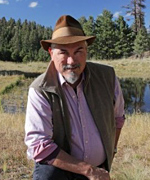 —Alan Dulaney
—Alan Dulaney
On June 28, the Bureau of Reclamation, ADWR, and CAWCD cohosted a meeting on the Lower Basin Drought Contingency Plan. While other Basin states have been getting their act together, Arizona has not made substantive progress on its internal plan, DCP Plus (a term that was barely mentioned during the presentations). That is about to change. Apparently ADWR and CAWCD have concluded a truce, because Tom Buschatzke (Director) and Ted Cooke (General Manager) did a tag-team style hosting of the presenters. They touted the meeting as a seminal event in Arizona water history, equivalent to the signing of the 2007 Shortage Sharing Guidelines. But I am not going into what they said; I will cover only the strong message I heard from the Bureau of Reclamation.
Recall the basics of the 2007 agreement. Tiered shortage levels are tied to falling water level elevations in Lake Mead. Shortage is declared at 1075 feet, Tier 2 starts at 1050 feet, and Tier 3 at 1025 feet. Of the Lower Basin states, Arizona is cut the most — all from the CAP canal. California never takes a cut under these criteria. And no one knows what happens below 1000 feet.
Terry Fulp of the Bureau of Reclamation presented the results of recent modeling runs. Two sets of runs were made, the first based on known historical hydrologic conditions since 1906, with an average annual flow of 14.8 million acre-feet (MAF). The second covered only the period 1988–2015, with an average annual flow of 13.2 MAF. He described this set of runs as the “stress test” case, in which abnormally high flows from the early part of the 20th Century and the large flows of the 1980s were avoided to give a more accurate picture of conditions in the near future, through 2026. Some 3,850 runs or traces produce predictions of conditions in Lakes Mead and Powell over the following 5 years. (Click here for a description of modeling assumptions.) These runs yield risk percentages for Lake Mead, falling within one of the three shortage tiers defined in 2007. Take a good look at the graphs of predicted water level elevations, and remember that the dashed lines are median values — so half of the runs fall above these lines and half fall below. Then take a look at the graphs of risk of falling below a given trigger level elevation. The risk percentages of shortage are bad enough under the historical flow conditions, but spike significantly under stress test assumptions. His entire presentation emphasized the growing risk of shortage, and soon. Hydrology is driving his directness.
The risk is real. Variability is increasing. Time grows short to get an internal Arizona consensus that will allow participation in the DCP along with the other Lower Basin states. It is clear to me that CAWCD and ADWR both recognize this truth, presented forcefully by Reclamation, and that is why, on this issue, they are in collaboration rather than conflict mode.
Reclamation’s final comments came from the new Commissioner, Brenda Burman. The conservative approach is to take action now. Hope is not a plan. California is close to resolving its internal differences and concluding agreements, as are other Basin states. Promises made by California for the DCP (conservation, participating in shortage) could evaporate if Arizona cannot achieve consensus. And if we don’t participate in the Lower Basin DCP, extreme pressure will be forthcoming from all other Basin states on the Secretary of the Interior to curtail Arizona deliveries from the Colorado River and leave the state to its own devices. The Secretary will be unlikely to ignore such pressure. He will act under his broad powers as Water Master of the Lower Basin. That is the iron fist in the velvet glove. That is what CAWCD and ADWR are listening to. They get it.